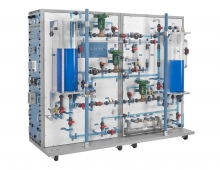Process Control Training: 4-Variable Advanced Process Control Skills
"What is Process Control?" It's a fairly common question for people unfamiliar with the concept. Process control is an industrial mechanism used for precision control of liquids and gases in industries like petrochemical, pharmaceutical, food processing, and more.
DAC Worldwide’s 4-Variable Advanced Process Control Training System is an industrial-quality instrumentation and fluid process control system that provides hands-on training for process operators to measure and control the four most common process variables: level, flow, pressure, and temperature.
An open architecture design allows you to customize the system to satisfy your specific training needs, including mixing and matching a variety of instruments and controls from multiple manufacturers. This flexibility lets you modify the system to adapt to changing training needs or technological advances.
The nearly-endless instrumentation choices and customization options have made this system a favorite of process technology programs and a powerful training tool for many industries.
Up to six learners can use the system simultaneously to create simple to advanced cascade, feed-forward, feedback, split range, ratio, and three-element control loops. The dynamic piping system can be configured as two separate loops or combined into one complex loop.
The system’s industrial-grade components give users hands-on experience with the equipment, instruments, and controls they’ll encounter. DAC Worldwide’s 4-Variable Advanced Process Control Training System offers comprehensive, hands-on process control training in a flexible, customizable, industrial-quality system for process operators.
-
Item Number:603-000Hands-on exercises include industry-relevant process control skills, such as: setting and adjusting pressure switches; installation and calibration of an electronic flow measurement channel; and determining a temperature, pressure, level, and flow process’ operation characteristics.




